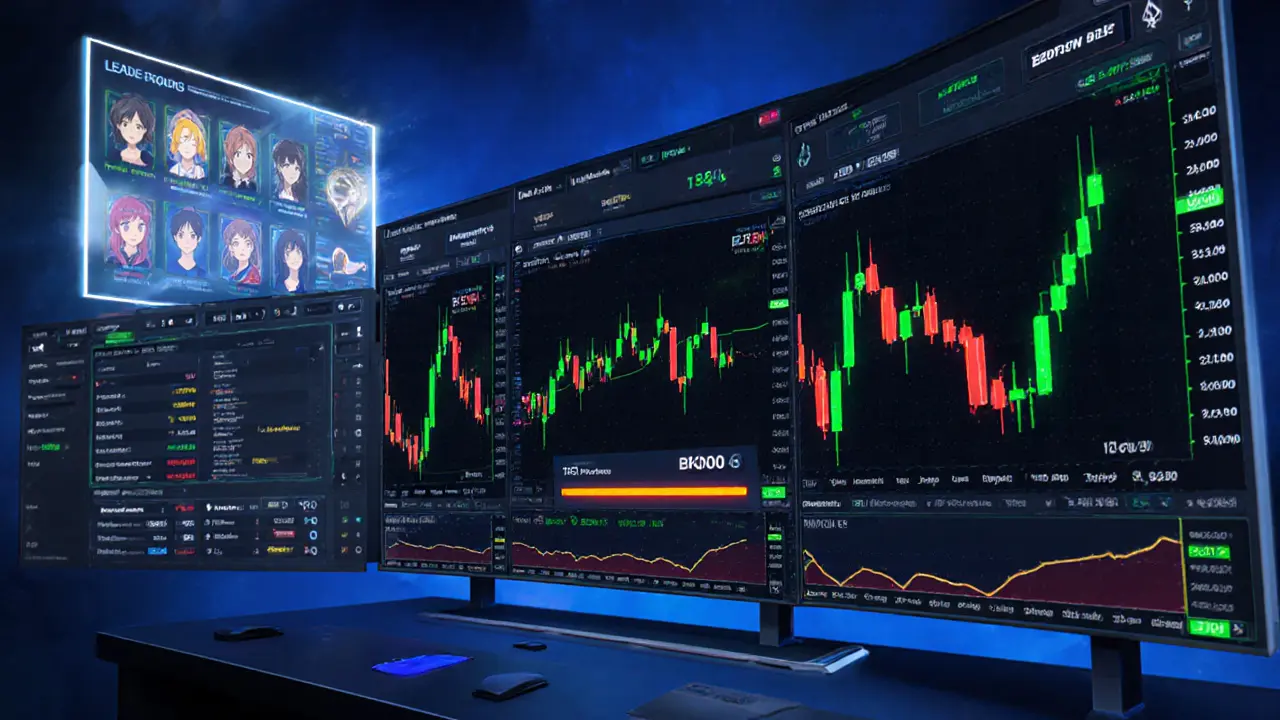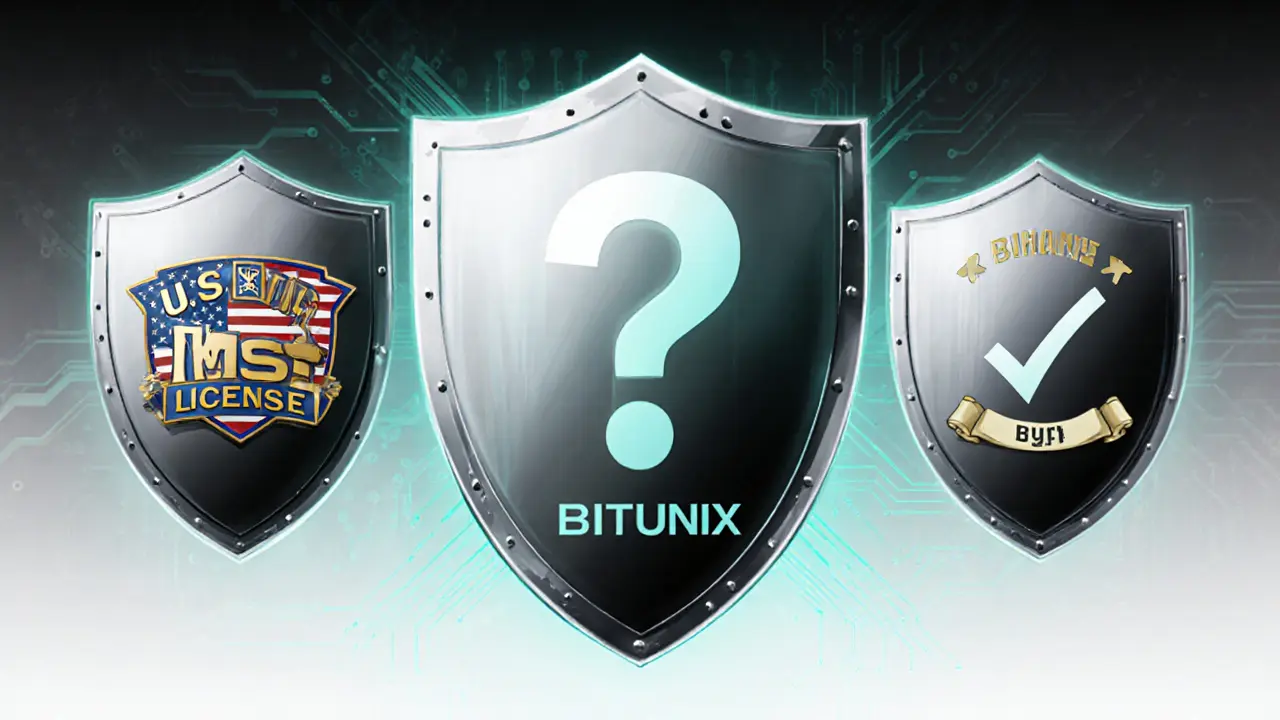Bitunix Crypto Exchange Feature Comparison Tool
Futures Trading
- Max Leverage: 125x (Bitunix)
- Margin Modes: Cross & Isolated
- Order Types: Limit, Market, Stop-Loss, Take-Profit
- Hedge Mode: Yes
Spot Trading
- Auto-Invest: Dollar-cost averaging
- Fee Transparency: Vague
- Volume: ~$80M (self-reported)
- Copy-Trading: Yes (in-app)
Security & Compliance
- U.S. MSB License: Yes
- Security Audits: None published
- Regulatory Coverage: Limited to U.S.
- KYC/AML: Basic compliance
Comparison Summary
| Feature | Bitunix | Binance | Bybit |
|---|---|---|---|
| Launch Year | 2022 | 2017 | 2018 |
| US License | MSB (yes) | None (offshore) | None (offshore) |
| Max Futures Leverage | 125x | 125x (selected contracts) | 100x |
| Spot Daily Volume* | ≈$80M (self-reported) | ≈$2B | ≈$400M |
| Maker Fee | ~0.02% (unverified) | 0.01%-0.02% | 0.025% |
| Taker Fee | ~0.05% (unverified) | 0.04%-0.06% | 0.075% |
| Security Audits | None published | Regular third-party audits | Annual audits |
| Copy-Trading | Yes (in-app) | No native feature | No native feature |
Key Takeaways
- Bitunix offers futures leverage up to 125x, a range that matches most top‑tier exchanges.
- It holds a U.S. MSB license, but independent security audits are not publicly available.
- Spot trading volumes and fee structures are vague; traders should verify costs before committing large sums.
- Promotional bonuses are generous, yet many are tied to high‑volume or referral requirements.
- For seasoned futures traders, Bitunix can be a viable option, but beginners may prefer more transparent platforms.
When you type "Bitunix crypto exchange review" into a search engine, you’re probably looking for a straight‑forward answer: is this platform worth your time and money? Below you’ll find a deep‑dive into the exchange’s core services, the security posture, fee landscape, and how it measures up against the big names like Binance and Bybit. By the end, you’ll know whether to open an account, keep it on the sidelines, or keep digging for a better fit.
What Is Bitunix?
Bitunix is a crypto derivatives exchange that provides futures, spot, and copy‑trading services. Launched in 2022, the platform claims to host more than 1.3million users worldwide and to have processed over $200million in futures volume. While those numbers sound impressive, they come mostly from the exchange’s own marketing; third‑party verification on sites like CoinMarketCap or CoinGecko is limited.
Trading Features: Futures, Spot, and Copy‑Trading
The heart of Bitunix is its futures market. Traders can take both long and short positions on major coins such as Bitcoin (BTC) and Ethereum (ETH), as well as a handful of altcoins. Leverage options range from 1x up to a staggering 125x, putting it on par with industry leaders.
- Margin modes: Choose between Cross Margin (shared across positions) or Isolated Margin (risk limited to each position).
- Order types: Limit, market, take‑profit, stop‑loss, trailing stop, and trigger orders are all available.
- Hedge mode: Enables simultaneous long and short exposure on the same asset.
- Multi‑window: Split the UI into several panels for monitoring different markets at once.
Spot trading is less featured but still functional. Bitunix offers an “auto‑invest” tool that lets users set up dollar‑cost averaging (DCA) strategies, which is handy for hands‑off investors. However, the platform does not publish its exact spot‑trading fees, and the advertised VIP fee‑discount tiers are vague.
Copy‑trading is marketed as a way for newcomers to mirror the strategies of top traders. The platform showcases a leaderboard, but performance history is presented without third‑party verification, so caution is advised.

Fees, Bonuses, and the Fine Print
Fee transparency is a common pain point for newer exchanges, and Bitunix is no exception. Publicly, it lists a “maker‑taker” model but omits exact percentages. Some users report maker fees around 0.02% and taker fees near 0.05%, but those numbers haven’t been confirmed by independent data sources.
On the upside, Bitunix runs frequent promotional campaigns. New users can claim a welcome bonus worth up to 100,000USDT, split across several trading milestones. Seasonal contests such as “Win2BTC” also draw attention, but the real cost often lies in the required trading volume to unlock the rewards.
Because the exchange holds a U.S. Money Services Business (MSB) license-US MSB license-it complies with basic AML/KYC standards. Still, you’ll need to submit ID documents, a selfie, and possibly proof of address before you can withdraw larger amounts.
Security and Regulatory Outlook
Security is where most exchanges earn or lose trust. Bitunix mentions “robust security measures” and a “proof‑of‑reserves” feature, but no third‑party audit reports have been published. There’s no public information about cold‑storage ratios, multi‑sig wallets, or insurance coverage for hacks.
The U.S. MSB license provides a baseline of regulatory compliance, yet the exchange does not quote any additional licences from the EU, Japan, or other major jurisdictions. For traders operating in those regions, the lack of local licensing could become a hurdle.
In short, while the platform appears to have taken standard KYC steps, the absence of independent security certifications means you should treat large deposits with caution and consider using hardware wallets for long‑term storage.
User Experience: Interface, Support, and Community
The UI is designed with beginners in mind. You can drag‑and‑drop widgets, resize chart windows, and toggle between dark and light modes. Mobile apps for iOS and Android are available, mirroring most desktop features.
Customer support is handled through a help center, live chat, and a Telegram community. Response times are not officially measured, but community members report mixed experiences-some get instant replies, while others wait hours. The help center hosts a decent collection of tutorials, though they’re all authored by Bitunix staff.

How Does Bitunix Compare to the Big Players?
Below is a snapshot comparison of Bitunix against two of the most widely used exchanges. Numbers for Binance and Bybit are taken from publicly available data as of October2025; Bitunix figures reflect the limited information disclosed by the platform.
| Feature | Bitunix | Binance | Bybit |
|---|---|---|---|
| Launch Year | 2022 | 2017 | 2018 |
| US License | MSB (yes) | None (operates offshore) | None (operates offshore) |
| Max Futures Leverage | 125x | 125x (selected contracts) | 100x |
| Spot Daily Volume* (USD) | ≈80M (self‑reported) | ≈2B | ≈400M |
| Maker Fee | ~0.02% (unverified) | 0.01%‑0.02% | 0.025% |
| Taker Fee | ~0.05% (unverified) | 0.04%‑0.06% | 0.075% |
| Security Audits | None published | Regular third‑party audits | Annual audits |
| Copy‑Trading | Yes (in‑app) | No native feature | No native feature |
*Numbers are approximate and drawn from publicly reported data as of October2025.
Pros and Cons
- Pros
- 125x leverage gives aggressive traders a real edge.
- US MSB license adds a layer of regulatory credibility.
- Intuitive UI and mobile apps are beginner‑friendly.
- Copy‑trading and auto‑invest tools provide passive‑trading options.
- Generous promotional bonuses attract new users.
- Cons
- Lack of independent security audit reports.
- Fee schedule is vague; real costs may be higher than advertised.
- Spot trading volume and liquidity are modest compared with top exchanges.
- Customer support quality varies; response times can be slow.
- Regulatory coverage is limited to the U.S.; other regions lack local licenses.
Final Verdict: Should You Trade on Bitunix?
If you’re a seasoned futures trader looking for high leverage and don’t mind doing extra legwork to confirm fee details, Bitunix can slot into your toolbox. The US MSB licence is a plus for American users, and the copy‑trading feature is a rarity among smaller exchanges.
Conversely, if you prioritize transparent fee structures, audited security, and deep liquidity for spot markets, you might feel more comfortable on Binance or Bybit. For newcomers, the platform’s promotional bonuses are tempting, but the fine print often demands significant trading volume-something to weigh carefully.
Ultimately, treat Bitunix as a niche player: good for specific futures strategies, but not a one‑stop shop for all crypto activity.
Frequently Asked Questions
Is Bitunix regulated?
Bitunix holds a U.S. Money Services Business (MSB) license, which means it follows basic AML and KYC rules in the United States. Outside the U.S., it does not list additional regulatory licences.
What is the maximum leverage for BTC futures on Bitunix?
The platform advertises up to 125x leverage on Bitcoin futures, which is on par with most major exchanges.
How do Bitunix’s fees compare to Binance?
Bitunix says it uses a maker‑taker model, but exact percentages aren’t publicly confirmed. Binance typically charges 0.01%‑0.02% maker and 0.04%‑0.06% taker. Until Bitunix publishes verified numbers, assume its fees could be slightly higher.
Can I use a hardware wallet with Bitunix?
Bitunix is a custodial exchange, meaning your funds stay in the platform’s wallets. For long‑term storage you should withdraw to a personal hardware wallet after trading.
What promotional bonuses are currently available?
New users can claim a welcome bonus of up to 100,000USDT, split across several trading milestones. Seasonal contests like “Win2BTC” also run from time to time, but they typically require high trading volume to claim.

Ciaran Byrne
October 6, 2025 AT 09:16Bitunix’s leverage is impressive but watch the fees.
Brooklyn O'Neill
October 9, 2025 AT 18:16Bitunix offers a decent UI for beginners, but the hazy fee schedule can bite you later. The US MSB license is a nice tick, yet the lack of third‑party audits keeps me uneasy. Overall, it feels like a middle‑ground platform – not bad, just not stellar.
Greer Pitts
October 13, 2025 AT 03:16Yo, I tried Bitunix last week and the 125x futures blew my mind, but the bonus terms are a nightmare. Gotta hustle that volume if you want the freebies, otherwise it’s just hype.
Lurline Wiese
October 16, 2025 AT 12:16Hold onto your hats, because Bitunix’s leverage is like a rollercoaster! One minute you’re soaring on 125x BTC, the next you’re scrambling for those vague fee details that disappear like a magician’s rabbit. The UI is slick, but the missing audit reports feel like a plot twist you didn’t sign up for. Drama aside, it could be a solid side‑kick for seasoned traders.
Jenise Williams-Green
October 19, 2025 AT 21:16The platform claims transparency, yet the fee numbers are shrouded in mystery. It’s a classic case of flashy marketing covering thin fundamentals.
Laurie Kathiari
October 23, 2025 AT 06:16Bitunix tries very hard to position itself as a competitor to the big dogs, but the reality is more nuanced. First, the 125x leverage is undeniably attractive for risk‑seeking traders, and it does match what Binance offers on select contracts. Second, the US MSB license provides a veneer of regulatory legitimacy that many offshore exchanges lack. However, the absence of any published security audits should raise red flags for anyone with a modicum of caution. When you cannot verify how the exchange safeguards its hot wallets, you are essentially placing blind faith in a black box. The fee structure is another opaque area; while the website hints at maker fees around 0.02%, the lack of independent verification means the actual cost could be far higher. Promotional bonuses, such as the 100,000 USDT welcome offer, sound generous, but they are tied to unrealistic trading volume thresholds that most retail users cannot meet. Liquidity on the spot market is modest, hovering around $80 million daily, which pales in comparison to Binance’s multi‑billion daily volume. For traders who need deep order books and minimal slippage, this could be a deal‑breaker. On the brighter side, the copy‑trading feature is a rare gem among smaller exchanges, giving newcomers a pathway to learn from more experienced players. Yet the performance records displayed lack third‑party verification, so you might be chasing a mirage. Customer support seems hit‑or‑miss; some users report swift help via live chat, while others endure hours of silence. The mobile app mirrors the desktop experience adequately, which is a plus for on‑the‑go trading. In sum, Bitunix is a niche platform that may serve specific futures strategies well, but it falls short as an all‑round crypto hub. If you value audited security and crystal‑clear fees, you’ll likely gravitate toward more established exchanges. Treat Bitunix with the same wariness you would any newcomer that promises big rewards with limited transparency.
Jim Griffiths
October 26, 2025 AT 15:16You’re right about the vague fees; the actual maker‑taker rates seem to sit around 0.02%/0.05% based on community reports, so double‑check before you swing large positions.
Matt Nguyen
October 30, 2025 AT 00:16All that transparency talk is a smokescreen-if you look closely, the exchange’s code isn’t even open‑source, which makes me wonder what they’re hiding behind that MSB badge.
John Corey Turner
November 2, 2025 AT 09:16Philosophically, an exchange that offers both high leverage and copy‑trading tries to merge the speculative with the educational, but without rigorous audits the ethical balance tilts toward opportunism.
Katherine Sparks
November 5, 2025 AT 18:16While the interface appears user‑friendly, my experience was hindered by ambiguous fee disclosures; I would advise prospective users to request a detailed fee sheet before depositing significant capital. 🙂
Kimberly Kempken
November 9, 2025 AT 03:16Everyone’s raving about the 125x leverage, but let’s not forget that such power attracts pump‑and‑dump schemes; if you’re not prepared to lose it all, steer clear.
Eva Lee
November 12, 2025 AT 12:16From a technical standpoint, the platform’s API latency is acceptable for spot trades, yet the futures order routing lacks redundancy, which could cause execution gaps during high volatility.
Carthach Ó Maonaigh
November 15, 2025 AT 21:16Yo, Bitunix is slick but the audit silence is a red flag-don’t be a patsy, keep your coins in a hardware wallet if you value safety!
Shaian Rawlins
November 19, 2025 AT 06:16I’ve been watching Bitunix since its launch in 2022, and while its UI has improved dramatically, the core issues remain: opaque fees, limited liquidity, and the ever‑present question of security audits. For newcomers, the auto‑invest feature might look appealing, but it’s essential to understand that the platform’s fee model could erode those small gains over time. Moreover, the promotional bonuses, though generous on paper, often require trading volumes that are unrealistic for average users, effectively turning the bonuses into a marketing gimmick. If you decide to use Bitunix, I recommend starting with a modest amount, monitoring the fee deductions on each trade, and withdrawing any profits to a personal wallet promptly. In the long run, a more established exchange with clear auditing practices may serve you better, but Bitunix can still be a learning tool if approached cautiously.
Tyrone Tubero
November 22, 2025 AT 15:16The drama of Bitunix’s promises is theatrical, but when the curtain falls you’re left with a platform that dazzles with leverage yet whispers about security. It feels like a high‑stakes gamble dressed up as a legitimate exchange.